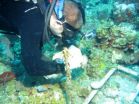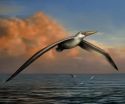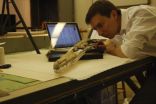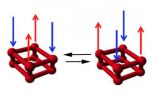(Press-News.org) MIAMI – A new study on biological erosion of mesophotic tropical coral reefs, which are low energy reef environments between 30-150 meters deep, provides new insights into processes that affect the overall structure of these important ecosystems. The purpose of the study was to better understand how bioerosion rates and distribution of bioeroding organisms, such as fish, mollusks and sponges, differ between mesophotic reefs and their shallow-water counterparts and the implications of those variations on the sustainability of the reef structure.
Due to major advancements in deeper underwater diving technology, a large renewal of interest in mesophotic reefs has pulsed through the scientific community because of their high biodiversity, vast extent, and potential refuge for shallower water reef species at risk from the impacts of climate change.
"Studying how mesophotic reefs function and thrive is especially critical now, when considering results from the new IPCC report reviewed by over 1700 expects said that coral reefs are the most vulnerable marine ecosystems on Earth to the adverse effects of climate change," said David Weinstein, Rosenstiel School Ph.D. student and lead author of the study. "Developing effective environmental management strategies for these important reef systems requires a basic fundamental understanding of the underlining architecture that supports and creates diverse biological ecosystems."
Weinstein and his research team used previously identified mesophotic reefs at 30-50 meters deep located in the U.S. Virgin Islands composed of a surprising number of coral growing on top different types of reef structures (patches, linear banks, basins) to better understand the role sedimentary processes have in creating and maintaining so many different structures that are critical for maximizing the biodiversity and health of the ecosystem. Researchers analyzed coral rubble and coral skeleton discs collected after one and two years of exposure to determine the sources and rates of bioerosion at these reefs.
Results of the study found that the architecturally unique structures in the study area experience significantly different bioerosion rates.
"This has very important implications when trying to predict how these reefs will grow over time and where preservation efforts might be most effective," said Weinstein.
Although erosion of the coral skeleton disks at the very deepest sites was more uniform, the researchers suggest that this is likely because the substrates used in the study were all of uniform composition, unlike the diverse composition of the sites. These results imply that bioerosional processes at these depths still exaggerate differences in reef structure depending on the amount of living and dead coral at each reef, the amount of time that material is exposed on the surface, and different localized current flows experienced.
The study also confirmed important concepts in coral geology research that lacked proof from studies venturing deeper than 35 meters. Coral reef bioerosion in the U.S. Virgin Islands and potentially in most of the Caribbean does generally decreases with depth. This result stems from the finding that parrotfish are now the most significant bioeroding group from shallow reefs down to a mesophotic reef transition zone identified by Weinstein at 30-35 meters in depth. The study also was able to conclude bioeroding sponges are the primary organisms responsible for long-term structural modification of mesophotic reefs beyond the transitional zone.
"Coral reefs are essentially a thin benthos veneer draped upon a biologically produced inorganic three-dimensional foundation that creates habitats for many marine organisms," said Weinstein. "Since mesophotic reefs grow so much slower than shallower reefs, identifying the sources and rate of erosion on mesophotic reefs is even more important to understand the long-term structural sustainability of these tropical reefs systems."
However, Weinstein suggests that other processes, such as coral growth rates and cementation, must also be more fully studied before scientists have a complete understanding of mesophotic coral reefs.
The paper, currently available online and scheduled for print in a special coral reef edition of the journal Geomorphology later this summer is one of the first to address mesophotic reef sedimentology.
INFORMATION:
More information, videos, pictures, and new developments can be found at: http://www.rsmas.miami.edu/users/dweinstein/ and at https://www.facebook.com/UmMesophoticGeologyLab
About the University of Miami's Rosenstiel School The University of Miami is one of the largest private research institutions in the southeastern United States. The University's mission is to provide quality education, attract and retain outstanding students, support the faculty and their research, and build an endowment for University initiatives. Founded in the 1940's, the Rosenstiel School of Marine & Atmospheric Science has grown into one of the world's premier marine and atmospheric research institutions. Offering dynamic interdisciplinary academics, the Rosenstiel School is dedicated to helping communities to better understand the planet, participating in the establishment of environmental policies, and aiding in the improvement of society and quality of life. For more information, please visit: http://www.rsmas.miami.edu.
New study of largely unstudied mesophotic coral reef geology
Researchers compare bioerosion on deeper reef systems to better understand long-term structural sustainability
2014-07-07
ELSE PRESS RELEASES FROM THIS DATE:
Discovery of Neandertal trait in ancient skull raises new questions about human evolution
2014-07-07
Re-examination of a circa 100,000-year-old archaic early human skull found 35 years ago in Northern China has revealed the surprising presence of an inner-ear formation long thought to occur only in Neandertals.
"The discovery places into question a whole suite of scenarios of later Pleistocene human population dispersals and interconnections based on tracing isolated anatomical or genetic features in fragmentary fossils," said study co-author Erik Trinkaus, PhD, a physical anthropology professor at Washington University in St. Louis.
"It suggests, instead, that ...
Bruce Museum scientist identifies world's largest-ever flying bird
2014-07-07
GREENWICH, CT, EMBARGOED UNTIL JULY 7, 2014 (3:00 PM EST) -- Scientists have identified the fossilized remains of an extinct giant bird that is likely to have the largest wingspan of any bird ever to have lived. A paper announcing the findings, "Flight Performance of the Largest Volant Bird," was published July 7 in the journal Proceedings of the National Academy of Sciences, and is authored by Dr. Daniel Ksepka, the newest Curator of Science at the Bruce Museum in Greenwich.
With a wingspan of 20 to 24 feet, Pelagornis sandersi was more than twice as big as the Royal ...
Scientist identifies world's biggest-ever flying bird
2014-07-07
DURHAM, N.C. -- Scientists have identified the fossilized remains of an extinct giant bird that could be the biggest flying bird ever found. With an estimated 20-24-foot wingspan, the creature surpassed size estimates based on wing bones from the previous record holder -- a long-extinct bird named Argentavis magnificens -- and was twice as big as the Royal Albatross, the largest flying bird today. Scheduled to appear online the week of July 7, 2014, in the journal Proceedings of the National Academy of Sciences, the findings show that the creature was an extremely efficient ...
Mathematical model illustrates our online 'copycat' behavior
2014-07-07
Researchers from the University of Oxford, the University of Limerick, and the Harvard School of Public Health have developed a mathematical model to examine online social networks, in particular the trade-off between copying our friends and relying on 'best-seller' lists.
The researchers examined how users are influenced in the choice of apps that they install on their Facebook pages by creating a mathematical model to capture the dynamics at play. By incorporating data from the installation of Facebook apps into their mathematical model, they found that users selected ...
Time of day crucial to accurately test for diseases, new research finds
2014-07-07
A new study published today in the journal PNAS (Proceedings of the National Academy of Sciences), has found that time of day and sleep deprivation have a significant effect on our metabolism. The finding could be crucial when looking at the best time of day to test for diseases such as cancer and heart disease, and for administering medicines effectively.
Researchers from the University of Surrey and The Institute of Cancer Research, London, investigated the links between sleep deprivation, body clock disruption and metabolism, and discovered a clear variation in metabolism ...
The quantum dance of oxygen
2014-07-07
Perhaps not everyone knows that oxygen has – quite unusually for such a simple molecule – magnetic properties. The phase diagram of solid oxygen at low temperatures and high pressures shows, however, several irregularities (for example, proper "information gaps" with regard to these magnetic properties) that are still poorly understood. A team of researchers from the International School for Advanced Studies (SISSA) and International Centre for Theoretical Physics Abdus Salam (ICTP) of Trieste, while trying to understand the origin of these phenomena, have identified a ...
DNA of 'Evolution Canyon' fruit flies reveals drivers of evolutionary change
2014-07-07
Scientists have long puzzled over the genetic differences between fruit flies that live hardly a puddle jump apart in a natural environment known as "Evolution Canyon" in Mount Carmel, Israel.
Now, an international team of researchers led by scientists with the Virginia Bioinformatics Institute at Virginia Tech has peered into the DNA of these closely related flies to discover how these animals have been able to adapt and survive in such close, but extremely different, ecologies.
One reason lies in a startling abundance of repetitive DNA elements that, until recently, ...
High earners in a stock market game have brain patterns that can predict market bubbles
2014-07-07
If you're so smart, why aren't you rich? It may be that, when it comes to stock market success, your brain is heeding the wrong neural signals.
In a study in the Proceedings of the National Academy of Sciences this week, scientists at the Virginia Tech Carilion Research Institute and Caltech found that, when they simulated market conditions for groups of investors, economic bubbles — in which the price of something could differ greatly from its actual value — invariably formed.
Even more remarkably, the researchers discovered a correlation between specific brain activity ...
Negar Sani solved the mystery of the printed diode
2014-07-07
VIDEO:
The video shows how a printed label picks up the radio signal from a telephone making a call, and uses the energy to switch the integrated display. This is only...
Click here for more information.
With an article published in the Proceedings of the National Academy of Sciences in the United States of America (PNAS), a thirteen-year-long mystery that has involved a long series of researchers at both Linköping University and Acreo Swedish ICT has finally been solved.
The ...
Neuroeconomists confirm Warren Buffett's wisdom
2014-07-07
Investment magnate Warren Buffett has famously suggested that investors should try to "be fearful when others are greedy and be greedy only when others are fearful."
That turns out to be excellent advice, according to the results of a new study by researchers at Caltech and Virginia Tech that looked at the brain activity and behavior of people trading in experimental markets where price bubbles formed. In such markets, where price far outpaces actual value, it appears that wise traders receive an early warning signal from their brains—a warning that makes them feel uncomfortable ...
LAST 30 PRESS RELEASES:
Making lighter work of calculating fluid and heat flow
Normalizing blood sugar can halve heart attack risk
Lowering blood sugar cuts heart attack risk in people with prediabetes
Study links genetic variants to risk of blinding eye disease in premature infants
Non-opioid ‘pain sponge’ therapy halts cartilage degeneration and relieves chronic pain
AI can pick up cultural values by mimicking how kids learn
China’s ecological redlines offer fast track to 30 x 30 global conservation goal
Invisible indoor threats: emerging household contaminants and their growing risks to human health
Adding antibody treatment to chemo boosts outcomes for children with rare cancer
Germline pathogenic variants among women without a history of breast cancer
Tanning beds triple melanoma risk, potentially causing broad DNA damage
Unique bond identified as key to viral infection speed
Indoor tanning makes youthful skin much older on a genetic level
Mouse model sheds new light on the causes and potential solutions to human GI problems linked to muscular dystrophy
The Journal of Nuclear Medicine ahead-of-print tip sheet: December 12, 2025
Smarter tools for peering into the microscopic world
Applications open for funding to conduct research in the Kinsey Institute archives
Global measure underestimates the severity of food insecurity
Child survivors of critical illness are missing out on timely follow up care
Risk-based vs annual breast cancer screening / the WISDOM randomized clinical trial
University of Toronto launches Electric Vehicle Innovation Ontario to accelerate advanced EV technologies and build Canada’s innovation advantage
Early relapse predicts poor outcomes in aggressive blood cancer
American College of Lifestyle Medicine applauds two CMS models aligned with lifestyle medicine practice and reimbursement
Clinical trial finds cannabis use not a barrier to quitting nicotine vaping
Supplemental nutrition assistance program policies and food insecurity
Switching immune cells to “night mode” could limit damage after a heart attack, study suggests
URI-based Global RIghts Project report spotlights continued troubling trends in worldwide inhumane treatment
Neutrophils are less aggressive at night, explaining why nighttime heart attacks cause less damage than daytime events
Menopausal hormone therapy may not pose breast cancer risk for women with BRCA mutations
Mobile health tool may improve quality of life for adolescent and young adult breast cancer survivors
[Press-News.org] New study of largely unstudied mesophotic coral reef geologyResearchers compare bioerosion on deeper reef systems to better understand long-term structural sustainability








